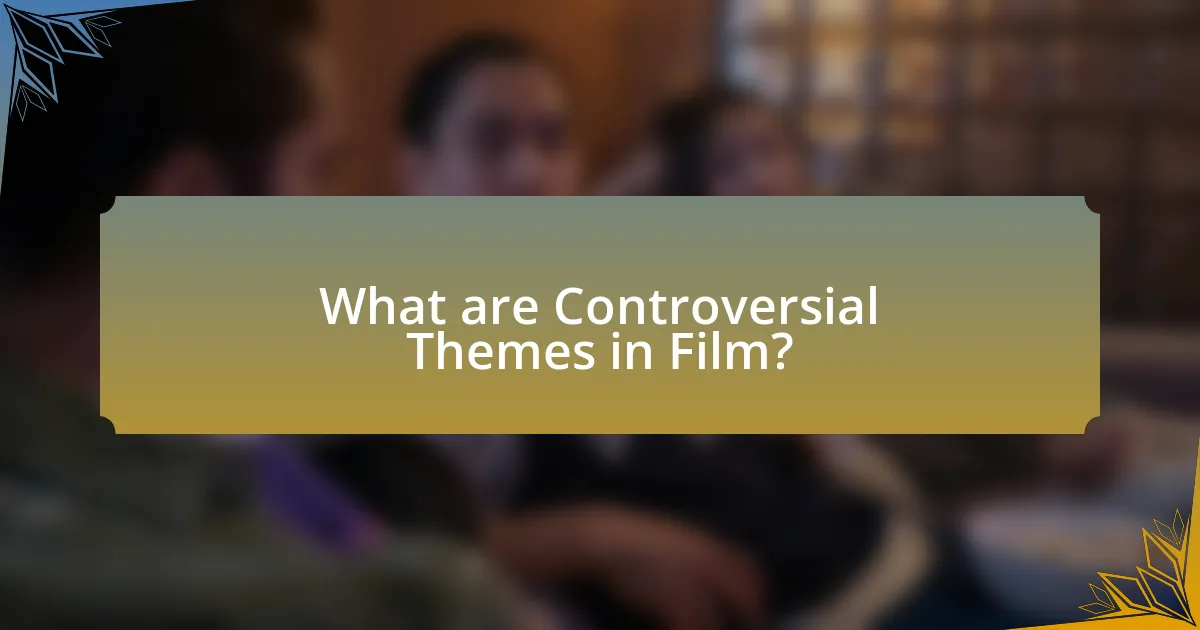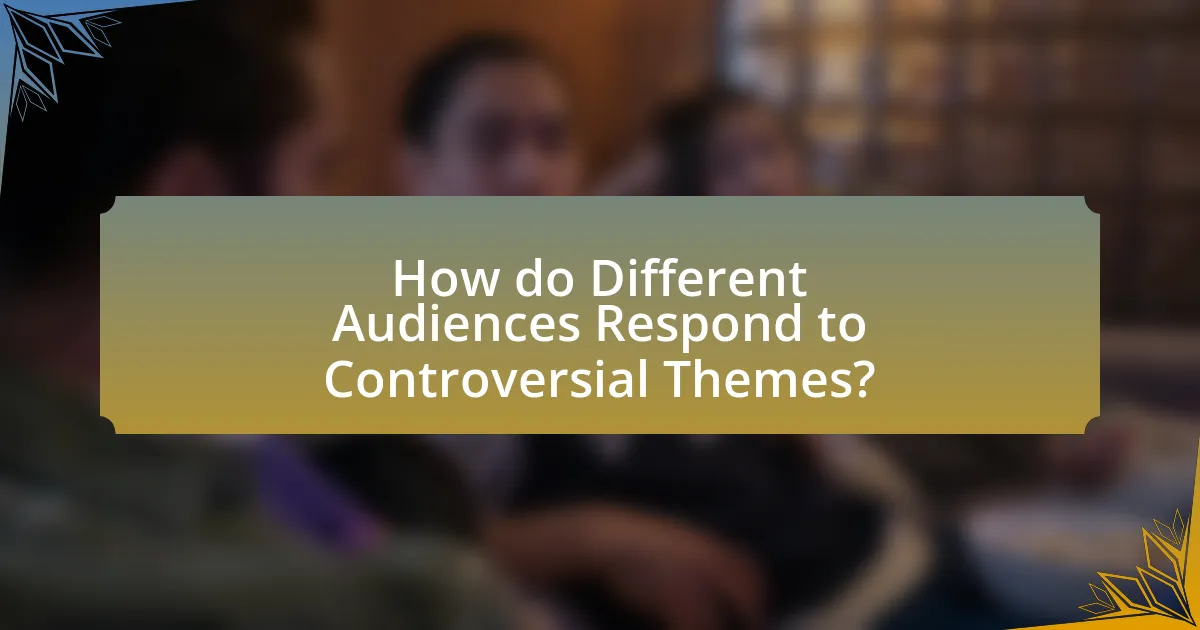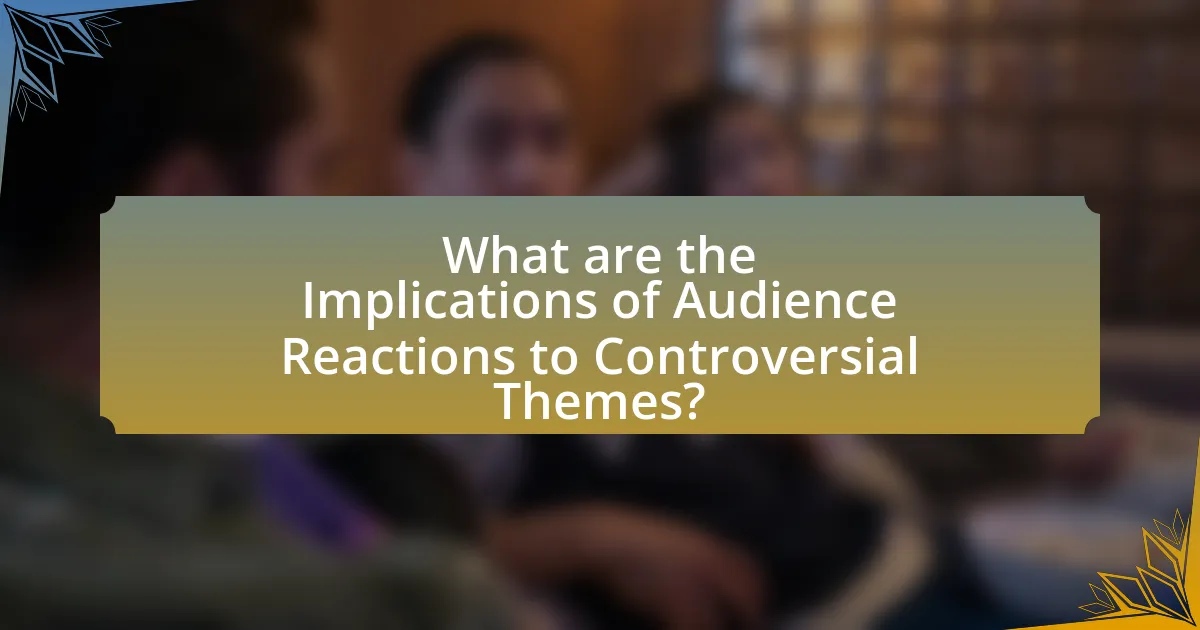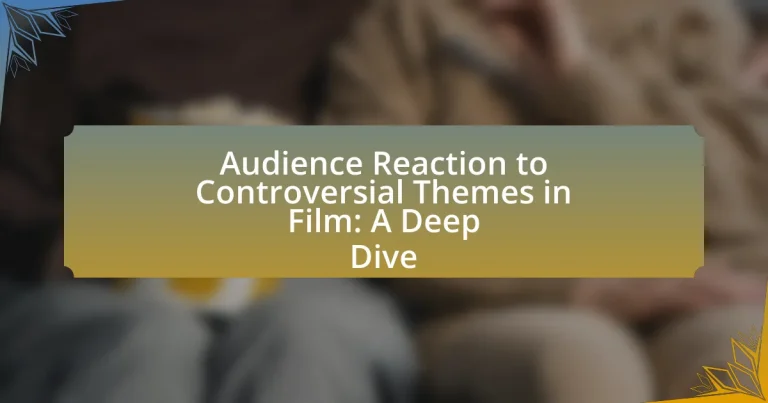The article examines audience reactions to controversial themes in film, highlighting how these themes provoke strong emotional responses and debates among viewers. It discusses various controversial topics such as racism, sexual orientation, violence, and mental health, and explores why filmmakers choose to address these subjects. The article also analyzes factors influencing audience reactions, including cultural backgrounds, personal experiences, and demographic variables, while emphasizing the role of marketing, reviews, and social media in shaping perceptions. Additionally, it addresses the implications of audience reactions for filmmakers and the film industry, including trends in production and strategies for navigating controversy.

What are Controversial Themes in Film?
Controversial themes in film are subjects that provoke strong reactions and debates among audiences, often challenging societal norms and values. Examples of these themes include racism, sexual orientation, violence, mental health, and political ideologies. Films like “American History X” address racism, while “Brokeback Mountain” explores sexual orientation, both sparking significant discussions and differing opinions. The presence of these themes can lead to polarized audience reactions, as seen in the varied responses to films like “A Clockwork Orange,” which tackles violence and morality. Such themes often reflect real-world issues, prompting viewers to confront uncomfortable truths and engage in critical dialogue.
Why do filmmakers choose to explore controversial themes?
Filmmakers choose to explore controversial themes to provoke thought and stimulate discussion among audiences. By addressing sensitive or divisive topics, filmmakers can challenge societal norms and encourage viewers to reflect on their beliefs and values. For instance, films like “12 Years a Slave” and “Brokeback Mountain” tackle issues of race and sexuality, respectively, sparking conversations that extend beyond the screen. This engagement can lead to increased viewership and critical acclaim, as audiences often seek out films that resonate with contemporary social issues.
What are some examples of controversial themes in film?
Controversial themes in film include topics such as racism, sexual violence, drug use, and political corruption. Films like “12 Years a Slave” address the brutal realities of slavery and racism, sparking intense discussions about historical injustices. “A Clockwork Orange” explores themes of violence and free will, leading to debates about morality and societal control. “The Hunt” delves into the complexities of political correctness and mob mentality, provoking strong reactions from audiences. Additionally, “Requiem for a Dream” presents the harrowing effects of drug addiction, challenging viewers to confront uncomfortable truths about substance abuse. These themes often elicit polarized responses, reflecting societal values and tensions.
How do controversial themes reflect societal issues?
Controversial themes reflect societal issues by highlighting the tensions, conflicts, and disparities present within a community. These themes often serve as a mirror, revealing underlying social dynamics such as inequality, discrimination, and moral dilemmas. For instance, films addressing topics like racial injustice or gender inequality provoke discussions that align with real-world movements, such as Black Lives Matter or the Me Too movement. By engaging audiences with these themes, filmmakers can stimulate critical conversations about societal norms and values, ultimately influencing public perception and policy.
How do audiences typically react to controversial themes?
Audiences typically react to controversial themes with a mix of engagement, discomfort, and polarized opinions. This reaction is influenced by individual values, cultural backgrounds, and personal experiences. Research indicates that films addressing controversial themes can provoke strong emotional responses, leading to discussions and debates among viewers. For example, a study published in the Journal of Communication found that films tackling social issues often elicit both support and backlash, reflecting the diverse perspectives within an audience. This dynamic illustrates how controversial themes can serve as catalysts for dialogue, highlighting the complexity of audience reactions.
What factors influence audience reactions to these themes?
Audience reactions to controversial themes in film are influenced by factors such as cultural background, personal experiences, and social context. Cultural background shapes viewers’ values and beliefs, which can lead to varying interpretations of themes. For instance, a study by the Pew Research Center found that individuals from different cultural backgrounds often respond differently to the same media content, highlighting the role of cultural context in shaping reactions. Personal experiences also play a crucial role; individuals who have faced similar situations may resonate more deeply with specific themes, leading to stronger emotional responses. Additionally, social context, including peer influence and societal norms, can affect how audiences perceive and react to controversial themes, as demonstrated by research from the Journal of Communication, which indicates that group dynamics can amplify or diminish individual reactions to media content.
How do cultural backgrounds affect audience perceptions?
Cultural backgrounds significantly influence audience perceptions by shaping values, beliefs, and emotional responses to content. For instance, individuals from collectivist cultures may prioritize community and familial relationships in their interpretation of film narratives, while those from individualistic cultures might focus on personal achievement and self-expression. Research by Hofstede (1980) highlights these cultural dimensions, showing that cultural context can alter the interpretation of themes such as conflict, morality, and social justice in films. This variation in perception can lead to differing reactions to controversial themes, as audiences filter content through their cultural lenses, affecting their engagement and emotional responses.
What role does marketing play in audience reactions?
Marketing significantly influences audience reactions by shaping perceptions and expectations before a film’s release. Through targeted campaigns, trailers, and promotional materials, marketing creates a narrative that can either align with or challenge audience beliefs about controversial themes. For instance, a study published in the Journal of Marketing Research found that films marketed with strong emotional appeals tend to elicit more intense audience reactions, both positive and negative. This demonstrates that effective marketing strategies can prime audiences to engage with the film’s themes in specific ways, ultimately affecting their overall reception and interpretation of the content.
How do trailers and promotional materials shape expectations?
Trailers and promotional materials shape expectations by presenting curated content that highlights key themes, characters, and plot elements, influencing audience perceptions before viewing. These materials often employ specific editing techniques, music, and visual styles to evoke emotional responses, thereby setting a tone that aligns with the film’s intended message. Research indicates that trailers can significantly impact audience anticipation; for instance, a study published in the Journal of Marketing Research found that well-crafted trailers can increase viewer interest by up to 30%. This demonstrates that the strategic presentation of content in trailers and promotional materials effectively shapes audience expectations and influences their overall reception of the film.
What impact do reviews and social media have on audience reception?
Reviews and social media significantly influence audience reception by shaping perceptions and expectations about films. Positive reviews can enhance interest and attendance, while negative reviews may deter potential viewers. For instance, a study by the American Psychological Association found that 70% of moviegoers consult reviews before deciding to watch a film, indicating the critical role of reviews in audience decision-making. Additionally, social media platforms amplify these effects by allowing users to share opinions and experiences, creating a feedback loop that can rapidly alter public perception. Research from the Journal of Marketing Research highlights that social media buzz can increase box office revenue by up to 20%, demonstrating the powerful impact of online discussions on audience reception.

How do Different Audiences Respond to Controversial Themes?
Different audiences respond to controversial themes in film based on their cultural backgrounds, personal beliefs, and social contexts. Research indicates that audiences with strong pre-existing beliefs may react defensively to themes that challenge their views, while those open to diverse perspectives may engage more thoughtfully with the content. For instance, a study published in the Journal of Communication found that viewers who identify with marginalized groups often resonate more with films addressing social justice issues, leading to heightened emotional responses and discussions. Conversely, audiences from conservative backgrounds may exhibit resistance or backlash against themes perceived as threatening to their values, as evidenced by viewer ratings and social media reactions to films like “Brokeback Mountain.” Thus, audience demographics and psychological factors significantly shape reactions to controversial themes in cinema.
What demographic factors influence audience reactions?
Demographic factors that influence audience reactions include age, gender, ethnicity, education level, and socioeconomic status. Research indicates that younger audiences tend to be more open to controversial themes, while older viewers may exhibit more conservative reactions. Gender differences also play a role; studies show that women often respond more emotionally to certain themes compared to men. Ethnicity can affect perceptions and interpretations of content, as cultural backgrounds shape individual values and beliefs. Additionally, higher education levels are associated with a greater tolerance for complex or controversial narratives, while socioeconomic status can influence access to media and exposure to diverse viewpoints. These factors collectively shape how audiences engage with and react to controversial themes in film.
How do age and gender affect perceptions of controversial themes?
Age and gender significantly influence perceptions of controversial themes, with younger audiences often displaying more progressive views compared to older generations. Research indicates that younger individuals are generally more open to diverse perspectives and less likely to hold traditional biases, which shapes their interpretation of controversial content. In contrast, older audiences may adhere to established norms and exhibit resistance to themes that challenge their beliefs. Gender also plays a crucial role; studies show that women tend to be more empathetic and sensitive to social issues, leading them to react differently to controversial themes than men, who may prioritize different aspects such as humor or action. For instance, a study published in the Journal of Communication found that women were more likely to express concern over themes related to gender equality, while men focused on themes of power dynamics. This divergence in perception highlights the complex interplay between age, gender, and the interpretation of controversial themes in film.
What role does education level play in audience interpretation?
Education level significantly influences audience interpretation by shaping critical thinking skills and contextual understanding. Individuals with higher education levels tend to analyze themes more deeply, recognizing nuances and complexities in controversial content. Research indicates that educated audiences are more likely to engage with and question the underlying messages in films, as they possess the analytical tools to dissect narrative structures and thematic elements. For instance, a study published in the Journal of Communication found that viewers with advanced degrees demonstrated a greater ability to interpret subtext and critique moral dilemmas presented in films, compared to those with lower educational attainment. This correlation highlights the importance of education in enhancing interpretative skills and fostering a more nuanced understanding of film narratives.
How do personal experiences shape audience reactions?
Personal experiences significantly shape audience reactions by influencing how individuals interpret and emotionally respond to content. These experiences create unique lenses through which viewers assess themes, characters, and narratives, often leading to varied reactions even among similar demographic groups. For instance, research indicates that individuals who have faced trauma may react more intensely to films depicting violence or loss, as their past experiences resonate with the on-screen events. This phenomenon is supported by studies in psychology, such as those by Cohen and Strayer, which demonstrate that personal history can evoke empathy or aversion, thereby altering the overall reception of a film’s message.
What psychological factors contribute to differing responses?
Psychological factors that contribute to differing responses include individual differences in personality, prior experiences, cultural background, and emotional state. Personality traits, such as openness to experience or neuroticism, influence how viewers interpret and react to controversial themes in film. For instance, research indicates that individuals high in openness are more likely to engage with and appreciate complex narratives, while those with high neuroticism may react negatively due to heightened sensitivity to emotional content. Additionally, prior experiences shape perceptions; viewers with personal connections to the themes presented may respond more intensely. Cultural background also plays a crucial role, as cultural norms and values dictate what is considered acceptable or offensive, leading to varied interpretations. Lastly, the emotional state of the viewer at the time of viewing can significantly affect their response, as mood can alter perception and engagement with the film’s content.
How do individual values and beliefs influence interpretation?
Individual values and beliefs significantly influence interpretation by shaping how individuals perceive and understand information. These personal frameworks act as lenses through which people filter experiences, leading to varied interpretations of the same content. For instance, research by Hall (1980) in “Encoding/Decoding” illustrates that audiences bring their cultural backgrounds and personal beliefs into the viewing experience, which affects their understanding of film themes. This means that a viewer’s moral values, political beliefs, and cultural context can lead to divergent interpretations of controversial themes in film, as evidenced by differing audience reactions to films like “Joker” or “Get Out,” where interpretations vary widely based on individual backgrounds and beliefs.
What are the common emotional responses to controversial themes?
Common emotional responses to controversial themes include anger, fear, sadness, and empathy. Audiences often react with anger when they perceive a theme as unjust or offensive, which can lead to heated discussions and debates. Fear may arise from themes that challenge societal norms or provoke anxiety about the future, while sadness can be a response to themes that highlight suffering or injustice. Empathy is frequently elicited when audiences connect with characters or situations that reflect their own experiences or evoke compassion. These emotional responses are significant as they can influence viewers’ perceptions and discussions surrounding the film, shaping cultural narratives and social discourse.
How do films evoke empathy or outrage in audiences?
Films evoke empathy or outrage in audiences through character development, emotional storytelling, and the portrayal of social issues. By creating relatable characters and immersive narratives, films allow viewers to connect emotionally, fostering empathy for the characters’ struggles. For instance, films like “Schindler’s List” depict the horrors of the Holocaust, prompting outrage and empathy by highlighting human suffering and moral dilemmas. Additionally, the use of music, cinematography, and pacing can intensify emotional responses, making the audience feel the weight of the depicted events. Research indicates that emotional engagement in films can lead to increased empathy, as demonstrated in studies published in the journal “Psychological Science,” which show that viewers often mirror the emotions of characters on screen.
What are the long-term effects of exposure to controversial themes?
Exposure to controversial themes can lead to desensitization, increased tolerance for diverse viewpoints, and potential shifts in personal beliefs over time. Research indicates that repeated exposure to contentious subjects in media can normalize previously taboo topics, making audiences more accepting of differing perspectives. For instance, a study published in the Journal of Communication found that individuals who frequently engage with controversial content demonstrate a greater openness to discussing sensitive issues, which can foster critical thinking and empathy. Additionally, long-term exposure may influence societal norms and values, as seen in the changing attitudes toward issues like LGBTQ+ rights and racial equality, which have been shaped by their representation in film and media.

What are the Implications of Audience Reactions to Controversial Themes?
Audience reactions to controversial themes significantly influence the cultural discourse surrounding films. These reactions can lead to heightened awareness of social issues, prompting discussions that may not have occurred otherwise. For instance, films addressing topics like racism or gender inequality often evoke strong responses, which can result in increased activism or changes in public policy. Research indicates that films like “12 Years a Slave” and “The Hate U Give” sparked conversations about systemic racism and police brutality, demonstrating how audience engagement can drive societal change. Additionally, negative reactions can lead to backlash against filmmakers or studios, affecting their future projects and the types of stories that are told. This dynamic illustrates the power of audience sentiment in shaping the film industry and broader societal narratives.
How do audience reactions influence future filmmaking?
Audience reactions significantly influence future filmmaking by shaping the decisions of studios and filmmakers regarding content, themes, and marketing strategies. When audiences respond positively to certain narratives or styles, filmmakers are more likely to replicate those elements in future projects to capitalize on their success. For instance, the success of films like “Black Panther,” which received widespread acclaim for its representation and storytelling, led to increased investment in diverse narratives within the industry. Conversely, negative audience reactions can prompt filmmakers to avoid specific themes or approaches, as seen with the backlash against films that fail to resonate with contemporary social values. This dynamic is supported by box office data and audience feedback metrics, which are increasingly utilized by studios to gauge potential success and inform future projects.
What trends can be observed in the types of films produced?
Recent trends in film production indicate a significant increase in the creation of films that tackle controversial themes, reflecting societal issues and cultural debates. This shift is evidenced by the rise of films addressing topics such as systemic racism, mental health, and gender identity, which have gained critical acclaim and audience engagement. For instance, films like “Get Out” and “Parasite” not only achieved commercial success but also sparked discussions on race and class disparities, respectively. Additionally, the prevalence of streaming platforms has facilitated the production of diverse narratives, allowing filmmakers to explore unconventional subjects that resonate with contemporary audiences.
How do box office results reflect audience sentiment?
Box office results reflect audience sentiment by indicating the level of interest and approval a film receives from viewers. High box office earnings typically suggest that the audience is engaged and has a positive perception of the film, while low earnings may indicate disinterest or negative sentiment. For example, films that tackle controversial themes often generate polarized reactions, which can be observed in their box office performance; a film that resonates with a particular demographic may perform well, while it may struggle in markets where the themes are less accepted. Historical data shows that films like “Joker” (2019) grossed over $1 billion worldwide, reflecting strong audience sentiment despite its controversial themes, whereas films that faced backlash, such as “The Hunt” (2020), experienced lower box office returns, illustrating how audience sentiment directly influences financial success.
What are the potential consequences for filmmakers?
Filmmakers may face significant consequences such as financial loss, reputational damage, and legal repercussions when addressing controversial themes in their work. Financial loss can occur if a film is boycotted or receives negative reviews, leading to lower box office sales; for instance, films that tackle sensitive subjects often see a polarized audience response, which can impact profitability. Reputational damage may arise from backlash against the filmmaker’s perceived stance on the issues presented, potentially affecting future projects and collaborations. Legal repercussions can include lawsuits related to defamation or copyright infringement if the content is deemed offensive or misrepresentative. These consequences highlight the risks filmmakers encounter when exploring provocative topics in their films.
How can backlash affect a filmmaker’s career?
Backlash can significantly hinder a filmmaker’s career by damaging their reputation and limiting future opportunities. When a filmmaker faces public criticism, it can lead to decreased audience support, reduced box office sales, and challenges in securing funding for new projects. For instance, the backlash against certain films, such as “The Hunt” or “Joker,” illustrates how negative audience reactions can result in financial losses and impact a filmmaker’s ability to work with studios. Additionally, filmmakers may find it difficult to collaborate with actors and crew members who are wary of associating with a controversial figure, further isolating them in the industry.
What strategies can filmmakers use to navigate controversy?
Filmmakers can navigate controversy by employing strategies such as proactive audience engagement, transparent communication, and careful content framing. Proactive audience engagement involves understanding the target demographic’s values and concerns, allowing filmmakers to tailor their messaging and marketing strategies accordingly. Transparent communication is essential; filmmakers should openly discuss their intentions and the themes explored in their work, which can help mitigate misunderstandings and foster dialogue. Additionally, careful content framing, which includes presenting controversial themes in a nuanced manner, can encourage audiences to reflect critically rather than react emotionally. Historical examples, such as the reception of films like “Brokeback Mountain,” demonstrate that when filmmakers engage audiences thoughtfully and address potential controversies head-on, they can foster a more constructive discourse around sensitive topics.
What best practices can filmmakers adopt when addressing controversial themes?
Filmmakers can adopt several best practices when addressing controversial themes, including thorough research, sensitivity to diverse perspectives, and fostering open dialogue. Conducting comprehensive research ensures that filmmakers understand the complexities of the themes they are exploring, which can lead to more nuanced storytelling. Sensitivity to diverse perspectives allows filmmakers to represent various viewpoints authentically, reducing the risk of alienating audiences. Additionally, fostering open dialogue with audiences and stakeholders can create a space for discussion and reflection, enhancing the film’s impact. These practices are supported by studies indicating that films addressing controversial themes can lead to increased audience engagement and critical discourse when handled thoughtfully.
How can filmmakers engage with audiences to foster understanding?
Filmmakers can engage with audiences to foster understanding by incorporating relatable narratives and diverse perspectives that resonate with viewers’ experiences. By using storytelling techniques that highlight emotional connections and shared human experiences, filmmakers can create a bridge between the film’s themes and the audience’s realities. For instance, films that address controversial themes often include character arcs that reflect real-life struggles, allowing viewers to empathize and reflect on their own beliefs. Research indicates that films with strong character development and authentic dialogue can significantly enhance audience engagement and understanding, as seen in studies like “The Impact of Narrative on Audience Engagement” published in the Journal of Media Psychology. This approach not only encourages dialogue but also promotes critical thinking about complex issues, ultimately leading to a deeper understanding of the themes presented.
What resources are available for filmmakers to research audience perspectives?
Filmmakers can utilize various resources to research audience perspectives, including audience surveys, focus groups, social media analytics, and box office data. Audience surveys provide quantitative data on viewer preferences and reactions, while focus groups offer qualitative insights through in-depth discussions. Social media analytics tools, such as Brandwatch or Hootsuite, allow filmmakers to gauge audience sentiment and engagement in real-time. Additionally, box office data can reveal trends in audience behavior and preferences, helping filmmakers understand what themes resonate with viewers. These resources collectively enable filmmakers to make informed decisions based on audience feedback and trends.


